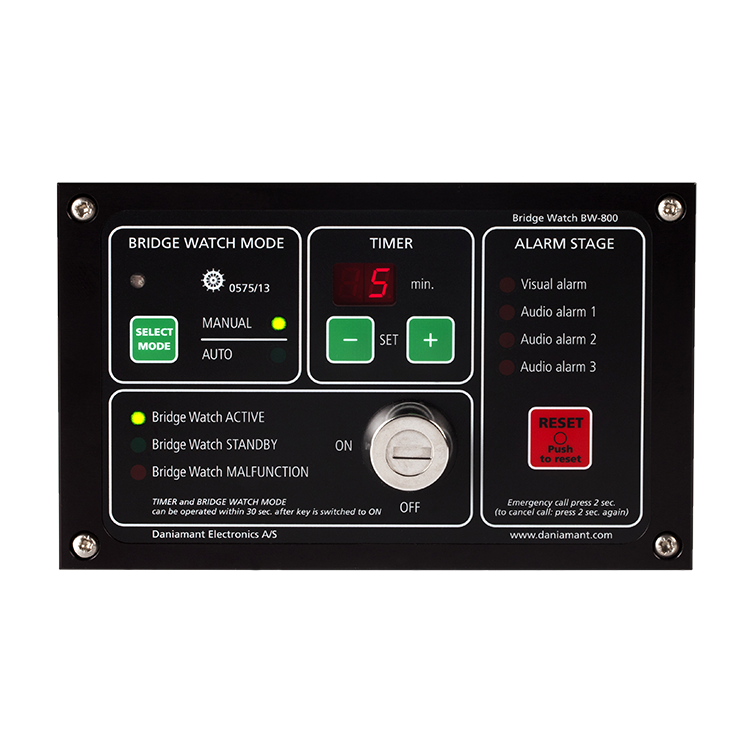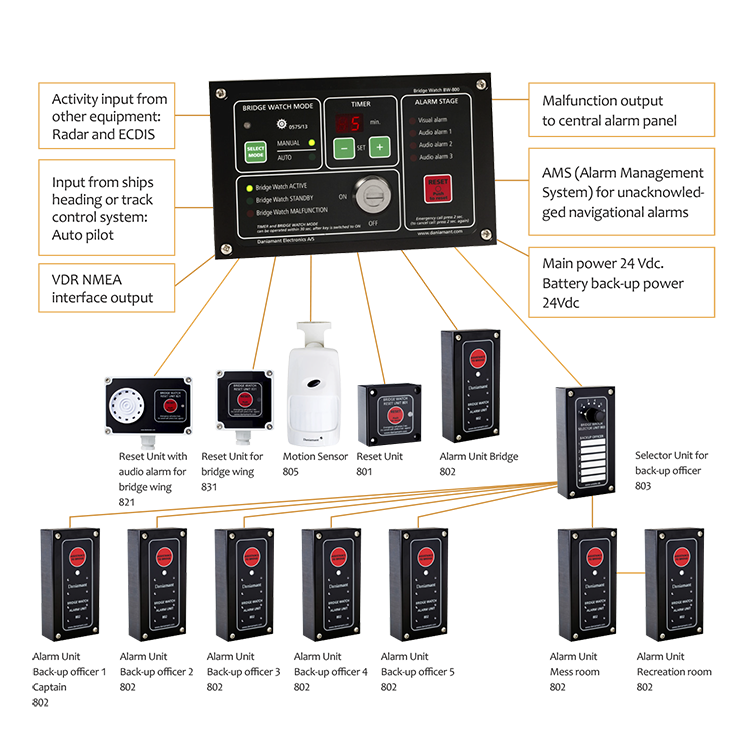* Please read and observe the BW-800 Disclaimer avialable in the Download section *
Please note that the MED-B & D overrules the DNV Type approval certificate for the BNWAS BW-800 model.
BNWAS BW-800 is produced in Denmark to ensure the high level of quality is maintained. BW-800 is designed as a cost effective product and it is easy to install which means low installation costs for the vessel owner.
The small size of the units makes it easy to install on vessels with limited space for new equipment. Most of the systems are installed as retrofit when the vessel is sailing from one port to another or installed the next time the vessel is in dock.
Normally, it is more cost effective to exchange an old dead man alarm with a new BNWAS than trying to upgrade the old system.
Deadlines for installation of BNWAS
1 July 2011: New Ships > 150 GT and all new passenger ships.
1 July 2012: Existing passenger ships and ships over 3.000 GT
1 July 2013: Existing ships over 500 GT
1 July 2014: Existing ships over 150 GT
BW-800 cable requirements:
Marine proof cable min. 0,5 mm² and maximum 1 mm². Terminals are made for maximum 1 mm² cables. Normally a cable with 6 x 0,5 mm² wires (3 pairs) is used.
Cable requirements per unit:
801: 5 wires 802: 2 wires 803: 4 wires 805: 3 wires 821: 6 wires 831: 5 wires
Why install BNWAS?
Regulations from IMO’s Maritime Safety Committee (MSC) requires carriage of a BNWAS Bridge Navigational Watch Alarm System complying with IMO performance standards.
The purpose of a bridge navigational watch alarm system (BNWAS) is to monitor bridge activity and detect operator disability which could lead to marine accidents. The system monitors the awareness of the Officer of the Watch (OOW) and automatically alerts the Captain or another qualified OOW if for any reason the OOW becomes incapable of performing the OOW’s duties.
This purpose is achieved by a series of indications and alarms to alert first the OOW and, if he is not responding, then to alert the Captain or another qualified OOW. Additionally, the BNWAS may provide the OOW with a means of calling for immediate assistance if required. The BNWAS should be operational whenever the ship’s heading or track control system is engaged, unless inhibited by the Captain.
The Purpose
The purpose of a BNWAS Bridge Navigational Watch Alarm System is to monitor bridge activity and detect operator disability which could lead to accidents. The system monitors the awareness of the Officer of the Watch (OOW) and automatically alerts another qualified OOW or the Captain if for any reason the OOW becomes incapable of performing the OOW’s duties.
This purpose is achieved by a series of indications and alarms to alert first the OOW and, if he is not responding, then to alert another qualified OOW or the Captain. Additionally, the BNWAS may provide the OOW with a means of calling for immediate assistance if required. The BNWAS should be operational whenever the ship’s heading or track control system is engaged, unless inhibited by the Captain.
BW-800 BNWAS complies with following standards:
- Wheel Mark
- IEC 62616 (New standard from February 2010)
- IMO MSC. 128(75) (Old recommandation from May 2002)
IMO performance standards for BNWAS
In February 2010 the new performance standard IEC62616 was adopted. IEC 62616 specifies the minimum performance requirements, technical characteristics and methods of testing, and required test results, for a bridge navigational watch alarm system (BNWAS) as required by Chapter V of the International Convention for the Safety of Life at Sea (SOLAS), as amended. It takes account of the general requirements given in IMO resolution A.694(17) and is associated with IEC 60945.
This means that from July 2011 all new ships over 150 GT has to be fitted with a type approved BNWAS complying with the new standard. Only a few systems have this new approval. Our new generation of BNWAS is called BW-800 and is Wheel mark approved and has several Type Approvals.
NEW! June 30th 2014 The IMO has issued interim guidance (contained in IMO circular MSC.1/Circ.1474) that the automatic operational mode on bridge navigational watch alarm systems BNWAS), if available, should not be used on a ship conforming with regulation SOLAS V/19.2.2.3. which requires the BNWAS to be in operation whenever the ship is underway at sea. Read more here >>>
The Danish Requirement in 2002
A multipurpose container feeder crashed into the Danish Great Belt Bridge on March 3, 2005 during a trip from Svendborg to Finland. The crash knocked two cranes off the ship, and destroyed the top deck of the ship’s bridge. A fire also broke out onboard. The chief officer was at the bridge, and was killed in the crash. Shortly after this accident the Danish Maritime Authority suggested IMO that BNWAS should be mandatory for vessels all over the world.
In 2002 The Danish Maritime Authority adopted the IMO released the resolution MSC.128(75) on performance standard for a Bridge Navigational Watch System (BNWAS) for Danish registered vessels starting with fishing vessels over 15 meters length and later on larger vessels. Only a few systems were available on the market and they were very expensive and too large to fit in a small fishing vessel. This was the reason why we designed and launched our first generation of a BNWAS in 2002 called BW-700 and with great success! The costumers valued the small size and competitive price.
Daniamant Electronics have supplied more than 700 BW-700 systems and more than 4000 BNWAS BW-800 Second Generation Type Approved BNWAS systems for all kinds of vessels.
IMO regulations for BNWAS
Regulations from IMO’s Maritime Safety Committee (MSC) requires carriage of a BNWAS Bridge Navigational Watch Alarm System complying with IMO performance standards.
Motion sensor
The BW-800 is delivered with a motion sensor as standard. Normally 1 to 3 motions sensors are needed depending on the bridge design and size. The sensors detect motion on the bridge and reset the internal timer in the BNWAS. These units are installed to minimize stress for the officer on watch because he does not have to activate the reset unit every 3 minutes, if he moves around regularly on the bridge.For safety reasons Daniamant Electronics have chosen to use a dual motion sensor with infrared and microwave detection in order to avoid a “non human” motion to reset the timer and a single sensor is not suitable for BNWAS systems.
Selector unit
With a selector unit it is possible for the OOW to select individually any of the navigation officers or the captain as being the assigned back-up officer for receiving the second stage remote audible alarm.
For vessels with DNV NAUT OC/AW notification it is required that the third stage remote audible alarm shall at least sound in the below locations:
- Captain’s cabin and office
- Officer’s office
- Officer’s mess
- Officer’s day room
- Cargo control room (if provided)
- Gymnasium (if provided)
- Prayer room (if provided)
- Other public rooms and areas (if provided)
Emergency call
If the officer on watch (OOW) needs assistance on the bridge, the BW-800 has an emergency call facility. If the reset unit is activated for more than 2 seconds, the back-up officer will be alerted immediately.
Maintenance free system
BW-800 has no internal battery back-up and does not require annual maintenance. BNWAS systems with internal battery back-up requires annual service and battery replacement. In the end, these systems will become very expensive for the vessel owner.
The BW-800 has been tested according to specifications from following classification societies:
- LR Lloyd’s Register of Shipping
- BV Bureau Veritas
- RINA Registro Italiano Navale
- ABS American Bureau of Shipping
- DNV Det Norske Veritas
- GL Germanischer Lloyd
- NKK Nippon Kaiji Kyokai
- RS Russian Maritime Register of Shipping
- CCS China Classification Society
- KR Korean Register of Shipping
BNWAS installation
The crew can do 90% of the installation (normally installation of cables and units). Connection to VDR, radar, ECDIS and Autopilot are normally done the next time they have a technician onboard for the annual VDR service. Connection to the VDR is normally most difficult, as the VDR may need a software update if it does not include a BNWAS input (this is the same issue for all BNWAS.
Additional BNWAS requirements from Classification Societies:
DNV additional requirements for BNWAS: Installation sites for BNWAS audio alarms:
– Bridge
– Captains cabin and office
– Officers’ office
– Officers’ mess
– Officers’ day room
– Cargo control room (if provided)
– Gymnasium (if provided)
– Prayer room (if provided)
– Other public rooms and areas (if provided)
MPA
Maritime And Port Authority Of Singapore (MPA) restrictions:
MPA does not accept motion sensors.
BNWAS BW-800 system complies with MPA regulations.
Class NK
NIPPON KAIJI KYOKAI (ClassNK) additional requirement for BNWAS:
One reset device should be provided to each bridge wing.
Where it is easy to reset a first stage alarm by a reset device located nearby in the wheelhouse, reset devices are not required to be fitted at bridge wings.
BNWAS BW-800 system complies with ClassNK regulations.
Lloyds Register
Lloyds Register accepts motion sensors installed on vessels without class notation NAV1 or IBS. However, Lloyds Register does not accept motion sensors installed on vessels with class notation NAV1 or IBS.
- Major Benefits
- Please note the BW-800 disclaimer
- Wheel mark approval
- Fully type approved
- Maintenance free system
- Compact unit – easy to install
- Dual Motion Sensor and Selector Unit
- Input for unacknowledged alarms
- Second generation BNWAS
- 24 months warranty
- BW-800 Disclaimer
- Product Brochure
- Check List
- Type Approval DNV MED-D
- Type Approval DNV MED-B
- Declaration of Conformity
- DNV-GL Type Approval Certificate
- RRR Type Approval Certificate
- USCG Type Approval Certificate
- BV Type Approval Certificate
- ABS PDA Certificate
CONTACT INFO
Daniamant A/S
Industrivej 24C
DK-3550 Slangerup
Tel +45 4737 3800
Fax +45 4737 3809
VAT No.: DK 1693 0997
Email: info@daniamant.com


